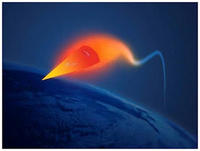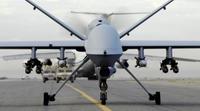-
ONR sensor and software suite tracks, hunts down more than 600 suspect boats
A new sensor and software suite sponsored by the Office of Naval Research recently returned from West Africa after helping partner nations track and identify target vessels of interest as part of an international maritime security operation
-
-
Novel network model to help in cyberwarfare, conservation, and disease prevention
Computer networks are the battlefields in cyberwarfare, as exemplified by the U.S. recent use of computer viruses to attack Iran’s nuclear program; researchers develop a computer model which could help military strategists devise the most damaging cyber attacks as well as guard America’s critical infrastructure
-
-
DARPA invests in hypersonic technologies

Stealth technology offered the U.S. military many advantages, but that strategic advantage is threatened as other nations’ abilities in stealth and counter-stealth improve; restoring that battle space advantage requires advanced speed, reach, and range; DARPA says that hypersonic technologies have the potential to provide the dominance once afforded by stealth to support a range of varied future national security missions
-
-
Advanced IED detectors save lives

Almost 60 percent of all coalition forces wounded or killed in Afghanistan since the start of the war in 2001 have been due to IEDs; to complicate matters, insurgents in Afghanistan have been increasingly constructing IEDs to circumvent simple metal detectors; some IEDs contain rudimentary materials such as wooden boards, foam rubber, and plastic containers; the finished product contains very little metal making it difficult for a traditional metal detector to pick up
-
-
First successful "spoofing" of UAVs demonstrated

A research team successfully demonstrated for the first time that the GPS signals of an unmanned aerial vehicle (UAV), or drone, can be commandeered by an outside source — a discovery that could factor heavily into the implementation of a new federal mandate to allow thousands of civilian drones into the U.S. airspace by 2015
-
-
DARPA’s UAVForge shows challenge of developing perch and stare UAV
DARPA’s UAVForge is a crowdsourcing competition to design, build, and manufacture an advanced small UAV; the competition aims to determine whether a loosely-connected community of UAV enthusiasts could develop a militarily relevant back-pack portable UAV with specific capabilities
-
-
New device allows users to scale walls, mountain faces
A group of mechanical and aerospace engineering students, using engineering principles, basic math, and ingenuity, have designed a system which would enable special operations force personnel, first responders, and members of search and rescue teams to scale buildings or mountain faces under a variety of conditions
-
-
Raytheon demonstrates missiles to engage swarms of small boats
In the event of a military a U.S.-Iran military clash, the Iranian Navy plans to use hundreds of small boats, equipped with anti-ship missiles, to attack larger U.S. ships in the waters of the Persian Gulf; the Griffin B missile from Raytheon aims to offer an answer to the small-boat problem, and the company says that in a recent live-fire demonstration, the U.S. Navy proved the ability of the Griffin B missile to engage rapidly moving small boats
-
-
Students build slingshot-driven test for artillery shells
The current method the U.S. Air Force uses to study the behavior of artillery shells causes these shells to be destroyed in the process; the Air Force wants to know more about the behavior of artillery shells as they accelerate and decelerate – and Rice University students invents a device to stop high-velocity projectiles without destroying them
-
-
Improving fast-moving mobile networks
Mobile ad hoc networks (MANETs) allow people in multiple, rapidly-moving vehicles to communicate with each other – a useful technology in for emergency-response situations or soldiers under fire; researchers have devised a method to improve the quality and efficiency of data transmission in these networks
-
-
Teaching robots to pick up oddly shaped objects
The use of robots in military and first response missions is growing; in some of these missions – for example, checking a suspicious object, lifting an oddly sahped IED off the floor — robots need more flexibility and dexterity than is currently available; researchers offer encouraging news on this front
-
-
U.S. Navy’s animal warriors enjoy the best of health care

The U.S. Navy is expanding the use of bottlenose dolphins and California sea lions to protect harbors from enemy swimmers, detect explosives on the seafloor, and perform other tasks such as guiding sailors through mine-laden waters or attaching recovery lines to lost equipment on the seafloor; the growing reliance on these mammals means that the Navy is also keeping a closer eye on their health
-
-
Protecting U.S. ships from Iranian speed-boat swarm attacks
In the event of a U.S. military attack on Iran’s nuclear facilities, the Iranians will adopt what the weaker side in a conflict typically does: engage in an asymmetric warfare; in the case of a naval clash, the Iranians are likely to use swarms of hundreds of small speed boats, equipped with anti-ship missiles and other weapons, to attack the much larger U.S. ships in the narrow confines of the Gulf; the U.S. Navy wants to use ray guns to deal with this threat
-
-
Laser weapon to protect ships from anti-ship missiles
Northrop Grumman tests next-generation high-energy, solid-state lasers; the test demonstrated that the laser could burn through the skin and critical components of a target drone used to simulate anti-ship cruise missile threats to U.S. Navy ships
-
-
DARPA wants technology to see through clouds
Soldiers who encounter enemy forces on the ground benefit from overhead aircraft support; some capabilities are lost, however, when cloud-cover obscures the view; DARPA is seeking advanced, flyable electronics and scene simulation technology for video synthetic aperture radar
-
More headlines
The long view
Bookshelf: Smartphones Shape War in Hyperconnected World
The smartphone is helping to shape the conduct and representation of contemporary war. A new book argues that as an operative device, the smartphone is now “being used as a central weapon of war.”
